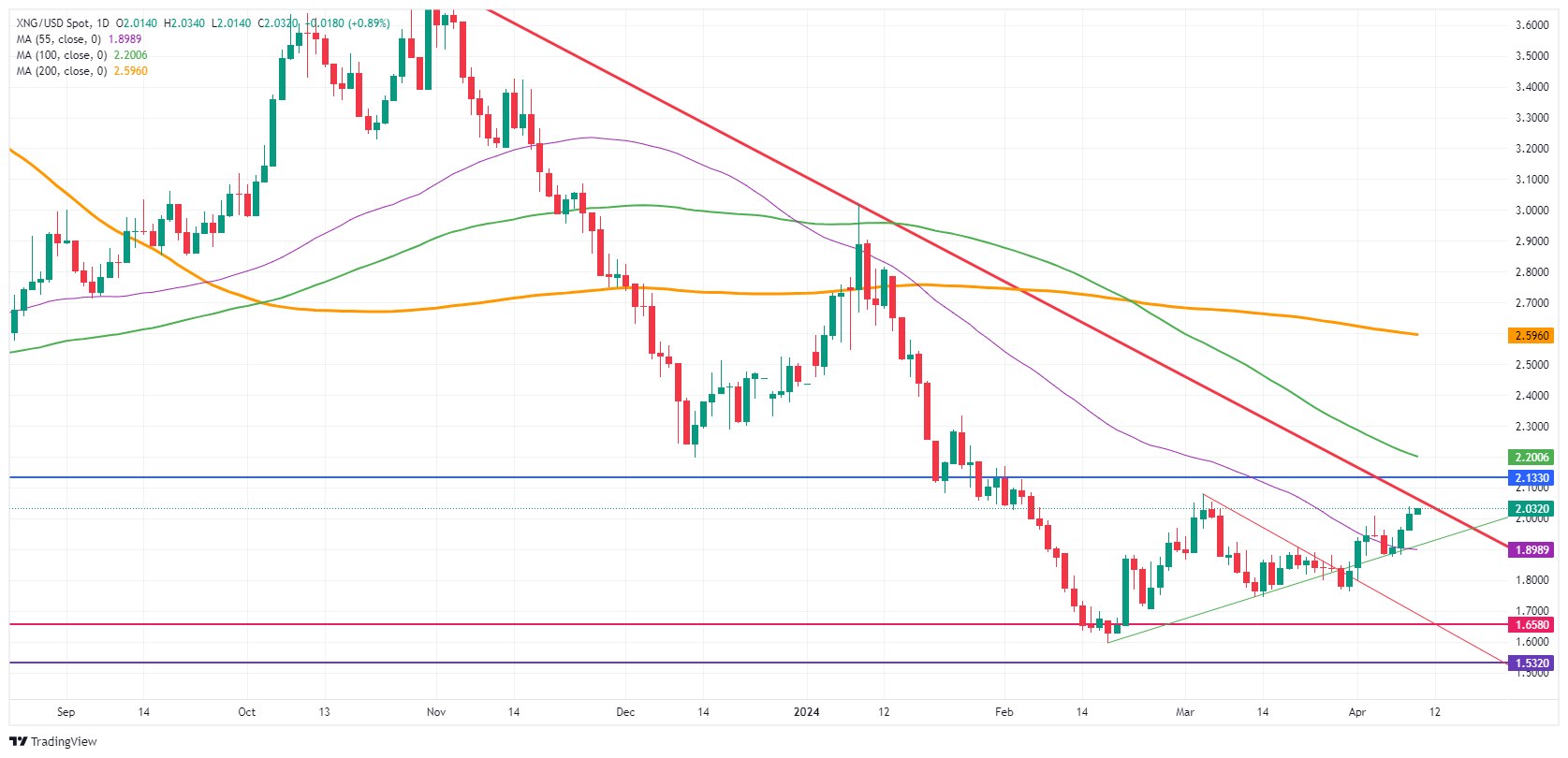- Natural Gas prices rise after learning that NATO is considering the idea of incorporating Ukraine.
- Meanwhile, PetroChina is set to expand its LNG business.
- The US Dollar Index orbits around 104.00 awaiting US CPI numbers and FOMC minutes.
The price of Natural Gas (XNG/USD) rebounds for the fourth consecutive day, registering a rise of almost 6.5% this week. Gas prices received another boost after a Bloomberg Intelligence article reported that diplomatic circles are talking about the idea of incorporating Ukraine into NATO, which would be adding oil to the fire for Russia. In addition, growing geopolitical tensions in the Middle East are supporting Gas prices, while Israel redirects its troops towards the border with Lebanon.
The US Dollar Index (DXY), meanwhile, is around 104.00 pending the release of the March Consumer Price Index (CPI), which appears crucial for the outlook for interest rates. for the rest of the year. A disinflationary data would be in line with what was communicated by the Fed. However, any surprise rebound could become a massacre for the markets, since investors could interpret that the president of the US Federal Reserve (Fed), Jerome Powell, and The broader Federal Open Market Committee (FOMC) are making the biggest policy mistake in decades. The publication of the minutes of the last Fed meeting could alleviate any extensive movement after the CPI publication this Wednesday.
Natural Gas is trading at $2.03 per MMBtu at the time of writing these lines.
News about Natural Gas: A risky bet
- Bloomberg Intelligence reported this morning in an article that the possibility of Ukraine joining NATO is being considered in diplomatic circles. Although this is only speculation, it would pose a certain risk that Russia would escalate the war in retaliation. Russia's complete cessation of its Gas deliveries to Europe or non-Eurozone countries through Ukraine could be the first of a series of steps in response if Ukraine were to join NATO.
- Yahoo Finance reports that PetroChina is willing to place orders to build more LNG vessels. This strategy fits with recent reports indicating that China is very active in the European Gas market and means its presence is here to stay.
- A headwind for Gas prices could come from Israel, which is finally considering a ceasefire in Gaza, although there is no real agreement yet. A ceasefire would ease tensions in the region and could bring Gas prices back below $2.00.
Technical Analysis of Natural Gas: 1982 Review
Natural Gas prices are rising due to two geopolitical factors. The idea that Ukraine could join NATO is a seismic shift in terms of power balances in Europe. This would force markets to reevaluate the entire energy complex, and both oil and gas would have to assume a huge risk premium for a long period of time. In the short term, any new rebound will come from the Middle East, after Israel announced the sending of troops to Lebanon under the pretext that Hezbollah is operating there, maintaining a potential risk of disruptions in Gas transit in the region.
With this rally heading into its fourth day, the next key mark on the upside is the all-time pivot point of $2.13. If Gas prices rise in that area, a wide area opens with the first stop at $2.20, near the 100-day SMA.
On the downside, the 55-day SMA around $1.89 should serve as a safety net. Next, multi-year lows at $1.60 will act as support, with $1.65 as the first line of containment. In the event of a break below these levels, investors should look at $1.53 as the next support zone.

Natural Gas: Daily Chart
Frequently asked questions about Natural Gas
What fundamental factors determine the price of Natural Gas?
The dynamics of supply and demand is a key factor that influences Natural Gas prices, and is in turn influenced by global economic growth, industrial activity, population growth, production levels and inventories. Climate influences Natural Gas prices because more Gas is used during cold winters and hot summers for heating and cooling. Competition from other energy sources influences prices as consumers may opt for cheaper sources. Geopolitical events, such as the war in Ukraine, also play a role. Government policies related to extraction, transportation and environmental issues also influence prices.
What are the main macroeconomic publications that influence Natural Gas Prices?
The main economic publication that influences Natural Gas prices is the weekly inventory bulletin of the Energy Information Administration (EIA), a US government agency that produces data on the gas market in the United States. The EIA Gas bulletin usually comes out on Thursday at 14:30 GMT, the day after the EIA publishes its weekly Oil bulletin. The economic data of the large consumers of Natural Gas can influence supply and demand, among which China, Germany and Japan stand out. Natural gas is primarily priced and traded in US dollars, so economic releases affecting the US dollar are also factors.
How does the dollar influence Natural Gas prices?
The US dollar is the world's reserve currency and most commodities, including Natural Gas, are quoted and traded in international markets in US dollars. Therefore, the value of the Dollar influences the price of Natural Gas, since if the Dollar strengthens, fewer dollars are needed to buy the same volume of gas (the price falls), and vice versa if the dollar strengthens.
Source: Fx Street
I am Joshua Winder, a senior-level journalist and editor at World Stock Market. I specialize in covering news related to the stock market and economic trends. With more than 8 years of experience in this field, I have become an expert in financial reporting.





